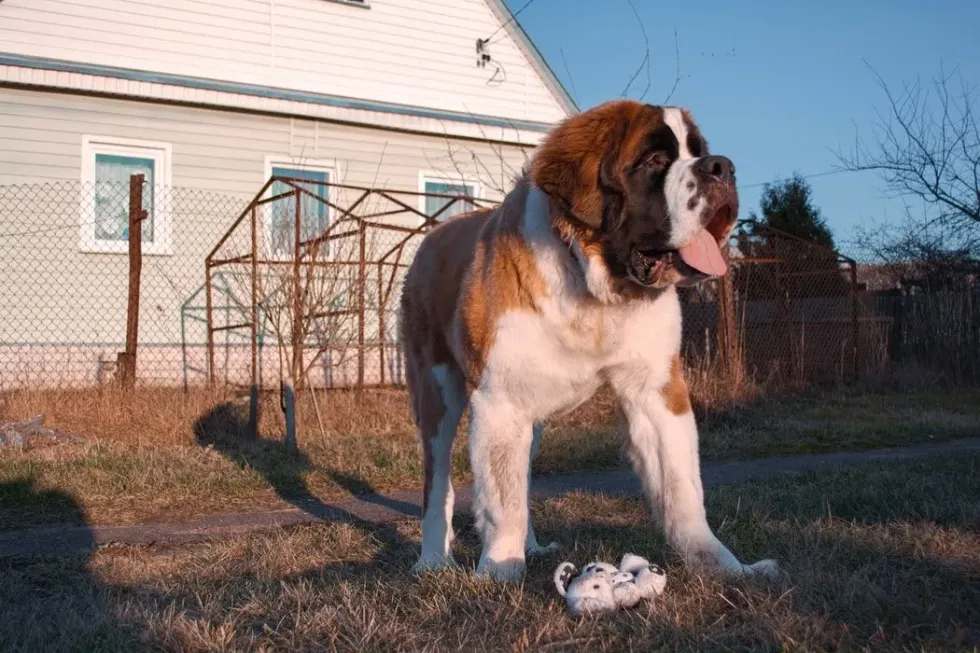Fun Saint Berdoodle Facts For Kids

Are you looking forward to getting a dog? You have come to the perfect place, as we are going to learn about the St Berdoodle.
It is a mixed breed dog formed by mating a St Bernard usually with a Standard Poodle. Most of them inherit the big size of a St Bernard and the look of a Poodle.
So, they essentially look like a giant Poodle in the body of a Saint Bernard. The medium-to-long coat of the St Berdoodle can either be coiled like a Poodle or wavy and smooth like that of a Saint Bernard.
The usual coat colors for this dog breed are white-brown, white-black, or white-red. They are burly dogs with great personalities and friendly nature. Even though they are not meant for apartment living, these teddy bear-like dogs are great for first-time dog parents.
They are fairly low-maintenance except for needing a bit more care while untangling their coat. As designer dogs, they have quickly become a favorite of many because of their affectionate temperament and kid-friendly nature.
Keep on reading to know more about his fabulous dog breed. Also, check out our articles on the Corgi and Newfoundland dog to know more about dog breeds.
Saint Berdoodle Interesting Facts
What type of animal is a Saint Berdoodle?
A Saint Berdoodle is a dog that is a special mix of Saint Bernard and a Standard Poodle.
What class of animal does a Saint Berdoodle belong to?
The Saint Berdoodle belongs to the class Mammalia and the family Canidae like all other dogs. The Saint Berdoodle scientific name is Canis lupus familiaris.
How many Saint Berdoodles are there in the world?
Saint Berdoodles are widely found around the world as family pets, so it would be hard to come up with their exact population. Any survey or studies are yet to be done to come to a conclusive number.
Where does a Saint Berdoodle live?
The Saint Berdoodle likes to live in comfortable human households where they affectionately cohabit with fellow humans and other pets.
What is a Saint Berdoodle's habitat?
The St Bernard Poodle mix likes a comfortable habitat that is neither too hot nor too cold. Because of their medium to thick coat, these dogs are unable to stay in a household that gets too warm.
The Saint Berdoodle also needs a lot of space, so they aren't really meant for small apartments. If you have a spacious backyard, the St Berdoodle will be forever grateful to you.
Try not to leave them alone for long periods as they cannot tolerate being left alone and may face separation anxiety. These big dogs are also good with children.
Who do Saint Berdoodles live with?
Saint Berdoodles are mixed breed dogs that have been bred to be designer dogs. So, they aren't meant to live in the wild. You will always find them living with their pet parents and other fellow humans.
Saint Berdoodles are quite social, and they bond with their humans right from being puppies. The dog breed is suitable for those who already have pets at their home. As they are easy to train, seldom will a person face problems managing the St Bernard Poodle mix Berdoodle.
How long does a Saint Berdoodle live?
The average lifespan of a Saint Berdoodle adult is about 8-12 years. The Saint Berdoodle lifespan can reach its maximum with great care at their homes. It will also depend on the health quotient of the parent breeds. So, it is important to know more about the Saint Bernard and Poodle parents before getting your Saint Berdoodle puppies.
How do they reproduce?
The reproduction process is quite similar to other dogs. The female St Berdoodle goes through estrus (heat) cycles.
If a female and a male Saint Berdoodle mates during that cycle, the female may become pregnant. The gestation period in dogs usually lasts between 58-68 days.
After that, the Saint Berdoodle puppies are born, and they are usually in a litter of 5-10. The litter size can be smaller if you have a mini Saint Berdoodle.
A puppy is totally dependent on the mother as they are born blind. The puppy wouldn't immediately have a coat like the St Bernard or the Poodle, which will take time.
You do need to remember that the dog breed is a designer breed. So, breeding two St Berdoodles wouldn't lead to the same result as breeding the large breed St Bernard with a Standard Poodle.
Breeders take time assessing the two parents before mating them to get a handpicked dog breed like the Saint Berdoodle. Each and every puppy of the litter comes out unique and may inherit more qualities from one parent or the other.
The Saint Berdoodle breed is considered an 'F1' breed as they are the first generation dog breeds produced by mating a Saint Bernard with a Standard Poodle. If a breeder chooses to breed a Saint Berdoodle with a Poodle, it will be considered an 'F1b' breed.
What is their conservation status?
As widely found dogs, the Saint Berdoodle breed is yet to make itself into any conservation list. As mixed breeds, the Saint Berdoodles are not yet considered by the American Kennel Club.
Saint Berdoodle Fun Facts
What do Saint Berdoodles look like?
Saint Berdoodles are a large dog breed with a wavy or curly coat. The coat color may vary between white-brown, white-black, and white-red, which mainly depends on their parents.
They generally have a medium-long coat, and some dogs may even have an undercoat. One of the best things about the dog breed is that they are low shedding.
They have a long body with a large head which may make them look a little daunting, but these dogs are extremely friendly. Their curly coat often covers their eyes and ears, hence needing regular trimming. The coat is often lighter on the belly while being darker at the top.
They have a nice tail which is evenly covered with the wavy or coiled coat giving it a fluffy appearance. The dogs also have long droopy ears like their parents, and the nose is usually black and shiny.

*Please note that the image shows a Saint Bernard, one of the parent breeds of the Saint Berdoodle dog breed.
How cute are they?
The St Berdoodle mostly looks like an overgrown poodle which makes them look extremely cute. You will want to pet it as soon as you lay eyes on a St Berdoodle.
How do they communicate?
Like other dogs, the St Berdoodle communicates via vocalization or through its scent. They are moderate barkers, so you wouldn't hear them vocalizing without the need for it.
However, as pet parents, you can definitely make them learn several commands and communication cues. Among other dogs, the St Berdoodle may use its urine to communicate, either for mating or to mark its territory.
How big is a Saint Berdoodle?
The average height of the Saint Berdoodle varies between 15-30 in (38-76 cm). Most of them do carry more genes from the Saint Bernard, which gives them a big boost in size.
However, there is also the mini St Berdoodle that can have a relatively small size like their Poodle parents. Compared to the St Berdoodle, one of their parents, St Bernard, grows to be 25-35 in (65-90 cm), so the former is a tad smaller compared to the latter.
How fast can a Saint Berdoodle run?
As a big dog breed, the St Berdoodle doesn't usually run at a fast pace. So, they may have a general speed of 15–20 mph (24-32 kmph) or even lower like other dog breeds.
How much does a Saint Berdoodle weigh?
The average weight of a full-grown Saint Berdoodle may vary between 40-180 lb (18-81 kg). The scale may look drastic, but the weight of these dogs often depends on their parents. If a puppy happens to inherit more genes from a Poodle, they may end up being smaller compared to other St Berdoodles.
What are their male and female names of the species?
The male St Berdoodle is called a dog, while a female St Berdoodle is called a bitch.
What would you call a baby Saint Berdoodle?
A baby Saint Berdoodle is called a puppy.
What do they eat?
Saint Berdoodles are big breeds, so they will usually eat more than the smaller dogs. They should have high-quality food that is meant for large dogs with similar energy, which is similar to their parent, Saint Bernard.
A Saint Berdoodle full-grown dog should feed on anywhere between 4-10 cups of protein-rich food.
Talk to a vet and they will recommend the best diet for your dog according to their specific needs. As they are mixed breed dogs, every puppy may have their own distinct food needs according to its energy level.
Are they hypoallergenic?
It is a common myth that some dogs are hypoallergenic. Allergy is mainly caused by the skin shed by a dog rather than their coat, so this fact has become quite controversial.
If someone has preexisting allergic health issues, it is better to talk to a doctor before getting a pet. However, these dogs are low shedding, due to which they are known for being the Saint Berdoodle hypoallergenic dog breed.
The breeding of the Saint Bernard and Poodle has made the St Berdoodle resistant to frequent shedding. Nevertheless, every dog will shed its coat, especially during the shedding season.
So, regular grooming of the dog is needed to maintain its coat health. Saint Berdoodle grooming is fairly easy, but their medium coat can get knotted if it is left without proper grooming.
Would they make a good pet?
Yes, the St Berdoodle can be an amazing family pet. The calm and composed Saint Berdoodle temperament makes them perfect candidates for households with kids and other pets. The dog is intelligent and easy to train right from its puppy stage.
Seldom will a St Berdoodle give trouble to their pet parents. They have moderate energy levels.
Their activity level can easily be replenished with daily exercise of 40-45 minutes. The St Berdoodle has also got the characteristics of Saint Bernards, which makes them a dog that will take care of you. They are always eager to please their fellow humans, and you will love making them learn tricks.
If you are interested in getting this teddy bear-like dog, you will need to shell out $1,000-$3,000. Yes, the dogs are a bit costly as they are specially bred to be designer breeds.
However, you may still find them in a shelter, and many dogs still need to be rescued.
Whenever you are rescuing or adopting a St Berdoodle, make sure to ask the breeder or organization about the health problems faced by the parent breeds. Knowing about the parent dogs is crucial in order to take good care of your pet.
Like all other dogs, even the Saint Berdoodle may face some health concerns. One of the common problems is hip dysplasia that is even seen in the parent breed of Saint Bernard.
Regular vet visits are essential to take good care of the dog. Other health problems may include ear infections, Wobbler syndrome, skin issues, Willebrand's diseases (poor blood clotting ability), and bloating problems. Even though ear infections aren't very common, it is best to give their large ears a thorough cleaning during grooming sessions.
Did you know...
The Saint Bernard is also known as a nanny dog as the dog breed is good at being patient with children. They even take care of the children. Moreover, the Saint Bernard dog breed was responsible for saving more than 2000 people during the period of 1700-1900. Saint Bernards are still used in life-saving work.
When did Saint Berdoodle breeding begin?
Saint Berdoodles started to be bred during the 1880s in the US. The exact timeframe of the Saint Bernard and Poodle parent breed isn't found.
Are Saint Berdoodles lap dogs?
Well, as a large dog, they wouldn't technically be considered lap dogs. However, the Saint Berdoodles would seldom agree with this definition.
They are almost unaware that they are a large dog, and they love to sit on your lap. Cozying up to humans is a Saint Berdoodle's characteristic. They are also known as a gentle giant for this reason.
Here at Kidadl, we have carefully created lots of interesting family-friendly animal facts for everyone to discover! Learn more about some other mammals including English Bull Terrier, or Welsh Terrier.
You can even occupy yourself at home by drawing one on our Saint berdoodle coloring pages.
We Want Your Photos!
More for You
See All
Bachelor of Arts specializing in Journalism and Mass Communication, Postgraduate Diploma in Sports Management

Moumita DuttaBachelor of Arts specializing in Journalism and Mass Communication, Postgraduate Diploma in Sports Management
A content writer and editor with a passion for sports, Moumita has honed her skills in producing compelling match reports and stories about sporting heroes. She holds a degree in Journalism and Mass Communication from the Indian Institute of Social Welfare and Business Management, Calcutta University, alongside a postgraduate diploma in Sports Management.
Bachelor of Journalism and Mass Communication

Ankit ShindeBachelor of Journalism and Mass Communication
Ankit is a Journalism and Mass Media graduate from the University of Mumbai. With experience in SEO, blog and article writing, and fiction writing, he is a versatile writer and content creator. In his free time, Ankit enjoys reading, writing, and listening to music.
Disclaimer
1) Kidadl is independent and to make our service free to you the reader we are supported by advertising. We hope you love our recommendations for products and services! What we suggest is selected independently by the Kidadl team. If you purchase using the Buy Now button we may earn a small commission. This does not influence our choices. Prices are correct and items are available at the time the article was published but we cannot guarantee that on the time of reading. Please note that Kidadl is a participant in the Amazon Services LLC Associates Program, an affiliate advertising program designed to provide a means for sites to earn advertising fees by advertising and linking to Amazon. We also link to other websites, but are not responsible for their content.
2) At Kidadl, we strive to recommend the very best activities and events. We will always aim to give you accurate information at the date of publication - however, information does change, so it’s important you do your own research, double-check and make the decision that is right for your family. We recognise that not all activities and ideas are appropriate for all children and families or in all circumstances. Our recommended activities are based on age but these are a guide. We recommend that these ideas are used as inspiration, that ideas are undertaken with appropriate adult supervision, and that each adult uses their own discretion and knowledge of their children to consider the safety and suitability. Kidadl cannot accept liability for the execution of these ideas, and parental supervision is advised at all times, as safety is paramount. Anyone using the information provided by Kidadl does so at their own risk and we can not accept liability if things go wrong.
3) Because we are an educational resource, we have quotes and facts about a range of historical and modern figures. We do not endorse the actions of or rhetoric of all the people included in these collections, but we think they are important for growing minds to learn about under the guidance of parents or guardians.







